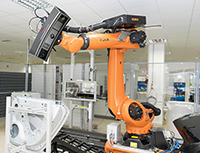3D surface inspection system
06/11/2019
 Precision sensor manufacturer Micro-Epsilon has launched a 3D non-contact surface inspection system for defect detection and for inspecting the aesthetic appearance of non-reflecting (matt, unpainted, plastic and bare metal) surfaces. The turnkey system enables fast, reliable 100% surface inspection and can be integrated directly into processing/assembly lines or on robots.
Precision sensor manufacturer Micro-Epsilon has launched a 3D non-contact surface inspection system for defect detection and for inspecting the aesthetic appearance of non-reflecting (matt, unpainted, plastic and bare metal) surfaces. The turnkey system enables fast, reliable 100% surface inspection and can be integrated directly into processing/assembly lines or on robots.The new surfaceCONTROL system from Micro-Epsilon is based on the principles of deflectometry and fringe projection, enabling even the smallest of surface defects to be recognised reliably and the inspection of surface aesthetics to be carried out.
surfaceCONTROL complements the company’s existing reflectCONTROL 3D surface inspection system, which is already being used by automotive vehicle manufacturers worldwide. Whereas reflectCONTROL is designed for the inspection of shiny, reflective, painted surfaces only, surfaceCONTROL measures against non-reflective surfaces such as matt, plastic, unpainted and bare metal surfaces, making it suitable for automotive press shop and body-in-white inspection. However, other industries where high-quality surface finish and consistency are important, such as aerospace manufacturing, will also benefit from the system.
surfaceCONTROL is designed for the inspection of diffuse surfaces, such as metallic surfaces (for example uncoated, electroplated, electrophoretic deposition (EPD)), plastic surfaces and ceramics. The sensor, which operates based on the fringe projection principle, scans the surface and generates a 3D point cloud. This point cloud is subsequently evaluated using specially developed tools in order to recognise extremely small defects and discontinuities on the surface. Sensors with different measuring ranges, areas and resolutions are available to suit any application.
surfaceCONTROL comprises a 3D smart sensor and two optional software packages. The new 3D sensor achieves significantly higher inspection speeds, together with increased measurement accuracy, by using a fast projection unit and new cameras. The modular design of surfaceCONTROL enables the system to be installed both offline (fixed mount) and as an in-process inspection (robot-mounted) system.
The sensors are available for measurement areas of 290 × 210 mm2 up to 570 × 430 mm2. The sensors detect a surface within typically 0.5 s per measurement area. The achievable lateral resolution is between 0.25 mm for small areas and 0.5 mm for the largest area. This means that surface deviations from 5 µm in height can be detected reliably. The depth of the measurement area of between 150 mm and 300 mm also enables reliable detection of zones with a strong curvature. By using planning software based on CAD data, larger test objects are separated into several measuring positions that are approached one after another. The system is designed in such a way that several robots can operate in one cell on the same test object in order to adapt inspection times to suit production cycle times.
www.micro-epsilon.co.uk